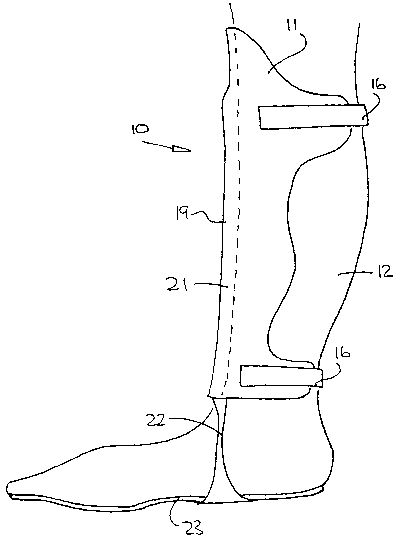Some of the information on this Web page has been provided by external sources. The Government of Canada is not responsible for the accuracy, reliability or currency of the information supplied by external sources. Users wishing to rely upon this information should consult directly with the source of the information. Content provided by external sources is not subject to official languages, privacy and accessibility requirements.
Any discrepancies in the text and image of the Claims and Abstract are due to differing posting times. Text of the Claims and Abstract are posted:
| (12) Patent Application: | (11) CA 2422734 |
|---|---|
| (54) English Title: | ANKLE/FOOT ORTHOSIS |
| (54) French Title: | ORTHESE PEDI-JAMBIERE |
| Status: | Deemed Abandoned and Beyond the Period of Reinstatement - Pending Response to Notice of Disregarded Communication |
| (51) International Patent Classification (IPC): |
|
|---|---|
| (72) Inventors : |
|
| (73) Owners : |
|
| (71) Applicants : |
|
| (74) Agent: | GOWLING WLG (CANADA) LLP |
| (74) Associate agent: | |
| (45) Issued: | |
| (86) PCT Filing Date: | 2000-11-08 |
| (87) Open to Public Inspection: | 2001-05-17 |
| Availability of licence: | N/A |
| Dedicated to the Public: | N/A |
| (25) Language of filing: | English |
| Patent Cooperation Treaty (PCT): | Yes |
|---|---|
| (86) PCT Filing Number: | PCT/GB2000/004288 |
| (87) International Publication Number: | GB2000004288 |
| (85) National Entry: | 2003-03-11 |
| (30) Application Priority Data: | ||||||
|---|---|---|---|---|---|---|
|
An ankle/foot orthosis (10) has a strapping member (11) for the lower leg, an
inflexible anterior longitudinal stiffener (21), a sole plate (23), and a
relatively flexible strut (22) connecting the stiffener (21) to the sole plate
(23). The flexible strut (22) permits a degree of ankle flexibility, and
promotes a more natural walking gait.
L'invention concerne une orthèse pédi-jambière (10) pourvue d'un élément de bandage (11) pour la jambe inférieure, d'un renfort longitudinal antérieur rigide (21), d'une semelle (23) et d'une entretoise relativement souple (22) reliant le renfort (21) à la semelle (23). L'entretoise souple (22) confère à la cheville un certain degré de souplesse et permet d'avoir une démarche plus naturelle.
Note: Claims are shown in the official language in which they were submitted.
Note: Descriptions are shown in the official language in which they were submitted.

2024-08-01:As part of the Next Generation Patents (NGP) transition, the Canadian Patents Database (CPD) now contains a more detailed Event History, which replicates the Event Log of our new back-office solution.
Please note that "Inactive:" events refers to events no longer in use in our new back-office solution.
For a clearer understanding of the status of the application/patent presented on this page, the site Disclaimer , as well as the definitions for Patent , Event History , Maintenance Fee and Payment History should be consulted.
| Description | Date |
|---|---|
| Application Not Reinstated by Deadline | 2005-11-08 |
| Time Limit for Reversal Expired | 2005-11-08 |
| Deemed Abandoned - Failure to Respond to Maintenance Fee Notice | 2004-11-08 |
| Letter Sent | 2003-07-09 |
| Inactive: Correspondence - Transfer | 2003-06-12 |
| Inactive: Courtesy letter - Evidence | 2003-06-10 |
| Inactive: Cover page published | 2003-06-10 |
| Inactive: Office letter | 2003-06-09 |
| Appointment of Agent Requirements Determined Compliant | 2003-06-09 |
| Revocation of Agent Requirements Determined Compliant | 2003-06-09 |
| Inactive: Office letter | 2003-06-09 |
| Inactive: Notice - National entry - No RFE | 2003-06-06 |
| Inactive: Single transfer | 2003-05-26 |
| Revocation of Agent Request | 2003-05-26 |
| Appointment of Agent Request | 2003-05-26 |
| Application Received - PCT | 2003-04-14 |
| National Entry Requirements Determined Compliant | 2003-03-11 |
| Application Published (Open to Public Inspection) | 2001-05-17 |
| Abandonment Date | Reason | Reinstatement Date |
|---|---|---|
| 2004-11-08 |
The last payment was received on 2003-10-20
Note : If the full payment has not been received on or before the date indicated, a further fee may be required which may be one of the following
Patent fees are adjusted on the 1st of January every year. The amounts above are the current amounts if received by December 31 of the current year.
Please refer to the CIPO
Patent Fees
web page to see all current fee amounts.
| Fee Type | Anniversary Year | Due Date | Paid Date |
|---|---|---|---|
| MF (application, 2nd anniv.) - standard | 02 | 2002-11-08 | 2003-03-11 |
| Reinstatement (national entry) | 2003-03-11 | ||
| Basic national fee - standard | 2003-03-11 | ||
| Registration of a document | 2003-05-26 | ||
| MF (application, 3rd anniv.) - standard | 03 | 2003-11-10 | 2003-10-20 |
Note: Records showing the ownership history in alphabetical order.
| Current Owners on Record |
|---|
| TYCO HEALTHCARE UK LIMITED |
| Past Owners on Record |
|---|
| SHANE WILLARD NICKSON |